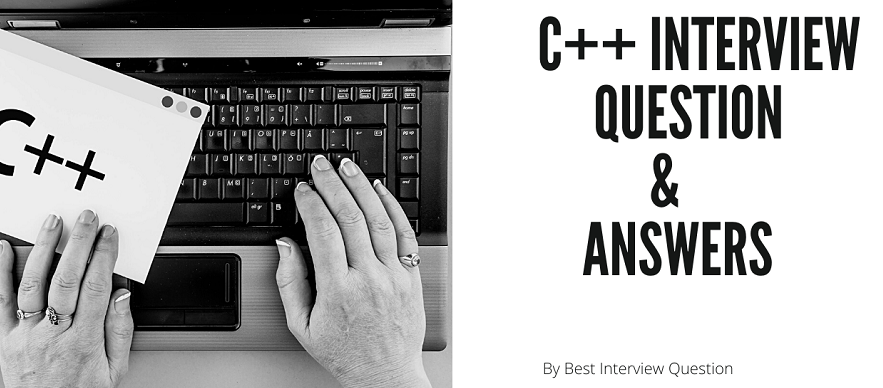C++ interview questions and Answers

Developed as “advanced” version of C, C++ works on similar concepts of C language while making significant performance gains in hardware. C++ is one of the top words STILL used on the world’s high web applications like facebook.com, google.com, youtube.com. C++ is also used to make games, and it is a hugely popular language in legacy system applications. We are also highlighting some of the C++ Interview Question and Answers for freshers and experienced as well.
Advantages of C++
- C++ is faster compared to high-level languages.
- C++ can be executed on many devices and is easily portable.
- C++ is perfect in individual bit changes, so it is ideal for hardware device drivers.
- C++ has an excellent function Library
- C++ is a fast and quick language.
- C++ allows the function overloading.
Most Frequently Asked C++ interview questions
Here in this article, we will be listing frequently asked C++ interview questions and Answers with the belief that they will be helpful for you to gain higher marks. Also, to let you know that this article has been written under the guidance of industry professionals and covered all the current competencies.
C++ is the object-oriented programming language.C++ is considered as one of the most esteemed languages to work with when it comes to Operating systems, and games.C++ language is a middle-level programming language designed by Bjarne Stroustrup in the year 1979 in Bell Laboratories. It is an object-oriented language that has features like Inheritance, Polymorphism, Encapsulation, and Abstraction.
It is used to teach the graphics libraries in high-level applications and the applications that are used to communicate with devices over the network.
The latest version of C++ is ISO/IEC 14882:2017 which is also known as C++17. This is the fifth edition.
| S.no | C Programming Language | C++ Programming Language |
|---|---|---|
| 1. | C is a procedural programming language | C++ is a procedural and object-oriented programming language |
| 2. | The data and functions are different entities | C++ data and functions both are encapsulated together into an object |
| 3. | Functions cannot be defined inside the structures | Functions can be described inside the structures |
| 4. | The information cannot remain hidden so that it can be manipulated by another code | Encapsulation hides the data thus protecting the data to get used by another code |
The benefits of C++ language are:-
- Faster compared to high-level languages.
- can be executed on many devices and is easily portable.
- very good in individual bit changes, so it is perfect for hardware device drivers.
- great function Library
- fast and quick language
- Allows the function overloading.
C++ is called OOPs because it supports Object-oriented Programming which means C++ look into the problem regarding objects rather than the procedure for doing that problem.
OOPS stands for Object-Oriented Programming.OOPS refers to the programming in which programming is based on the objects that can contain data and code rather than based on the functions and procedures.
Features of OOP
- Object
- Class
- Data Hiding and Encapsulation
- Dynamic Binding
- Message Passing
- Inheritance
- Polymorphism
Class:- Class is the collection of the same type of objects and objects are the variables of the type Class and once the Class has been defined any number of objects can be added to that same class. For examples Eagle, Sparrow, Pigeon, Crow are the objects of the Class Bird
Objects:- Object is the collection of the entities, and the objects occupy the space in the memory. An object contains data and code. When any program is executed the objects interact with each other by sending the messages without knowing their data and code.
The simple meaning of polymorphism is more than one form. In C++ a program can have more than one function with the same name that can perform different activities
Types of polymorphism in C++
- ad-hoc polymorphism
- parametric polymorphism
- subtype polymorphism
In C++ loop is used to perform specific repetitive tasks until a condition is satisfied.
TYPES OF LOOPS
1.FOR LOOP
for ( variable initialization; condition; variable update ) {
// Code to execute while the condition is true
}
2. WHILE LOOP
while ( condition )
{
// Code to execute while the situation is true
};
3. DO-WHILE LOOP
do {
} while ( condition );
Reference variable in C++ is used to give the alternative name to the already defined variable. There is one condition that the reference variable must be initialized at the time of declaration. The reference variables are declared by putting ‘&’ in the constitution
A member function of a class in C++ is a function that has its definition or its prototype within the class like any other variable. Member function operates on an object of the quality of which it is a member, and it has access to all the members of a class for that object.
A member function can be defined inside the class and outside the class.
In C++ every object can access its address through this pointer, in other words, it holds the address of the current object or points to the current object.
| S.no | Class | Structure |
|---|---|---|
| 1. | Members of Class are Private | Members of Class are Public |
| 2. | Declared as Class | Declared as Struct |
| 3. | Used for a more significant amount of Data | Used for a smaller amount of Data |
| 4. | Supports Inheritance | Does not support Inheritance |
| 5. | The object is created on the Heap memory | The objective is formed on the Stack Memory |
